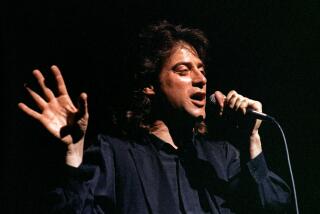A Little of This and a Lot of That
- Share via
SANTA ANA — Imagine a time when sex was taboo for discussion, let alone depiction, in mainstream culture, and you get a sense of the charge Little Richard’s great ‘50s recordings planted in audiences.
Listeners knew that Long Tall Sally was built for more than speed and that, in “Tutti-Frutti,” the gal named Sue who knew just what to do knew it in the biblical sense.
At 65, Little Richard is too smart to believe he can slam back to the era when he put out a call to orgiastic arms. Instead, he has long presented himself as a cutely outrageous public personality with lots of familiar trademarks. At the Galaxy Concert Theatre here on Sunday, Little Richard (born Richard Penniman) spent the first half of his show touching the bases of his persona.
There was the braggadocio about his “beautiful” looks and his potency as “the originator” of rock ‘n’ roll. There were the scads of pouty, mock-serious admonitions to all actual and potential interrupters of Richard to “shut up.” Somewhat more interestingly, there were the references to racial divisions and sexual ambiguity, highly charged issues that seemed safe coming from such a world-class jester.
For an hour or so, Richard put on an unremarkable oldies revue, heavy on the trademark falsetto “whoo-whoo”-ing, far too heavy on the booming bass frequencies (the band included two bassists and two drummers) and not even lightly evocative of sexual heat.
But early rock ‘n’ roll wasn’t only about sexual heat and fabulous, erotically charged personalities such as Richard, Elvis Presley and Jerry Lee Lewis. It was, and still is, music that didn’t try to shake off the Southern earth from which it rose, rich in the musical nutrients of gospel, country and rhythm and blues. After pacing through 10 songs of a so-so rock oldies revue, Richard and his 10-man band went back to his roots and turned the show into a superb, spontaneous look at where rock ‘n’ roll came from.
The turning point was a country-waltz version of the Leadbelly folk classic “Goodnight Irene.” Richard sang it with soulful commitment, far exceeding the husky-toned, ordinary rock ‘n’ roll singing he had been doing. He led the audience in sing-along choruses, then repeated semi-yodeled verses with an intensity and intimacy that shook off the dust on one of America’s best-known songs. He brought alive the song’s essence: the battle inside one soul between impulses toward a wild, fringe life of “gamblin’ and ramblin’ ” and the desire to honor family virtues of respectability and stability.
From there, Richard went into a fine R&B; history lesson. Ray Charles’ “I Got a Woman” and his own “Tutti-Frutti” were naturals. The brilliant stroke was following them with a version of the Police’s “Every Breath You Take.” Richard’s freely interpretive, down-home vocal made it clear how tied this still-current hit (thanks to Puffy Combs’ lucrative appropriation as “I’ll Be Missing You”) is to Southern R&B; ballad forms from the 1950s.
*
At some point, Little Richard started promising repeatedly that, though he had to leave right away, he wouldn’t go without playing “Long Tall Sally.” Instead, his piano-pounding hands would find their way to yet another great roots-music number, including a couple of gospel tributes to Mahalia Jackson and a Muddy Waters blues romp. His band followed each cue, playing with enthusiasm and affection for Little Richard that was clearly mutual.
Richard went on and on, stretching the show past the two-hour mark, an unheard-of generosity for a ‘50s hero. He eventually dispatched “Long Tall Sally” in one rushed, perfunctory verse, declining to take a final thrust at libidinous glories of old. But that hardly mattered; Little Richard had already shown that he has other, more age-appropriate ways to give satisfaction.
More to Read
The biggest entertainment stories
Get our big stories about Hollywood, film, television, music, arts, culture and more right in your inbox as soon as they publish.
You may occasionally receive promotional content from the Los Angeles Times.











